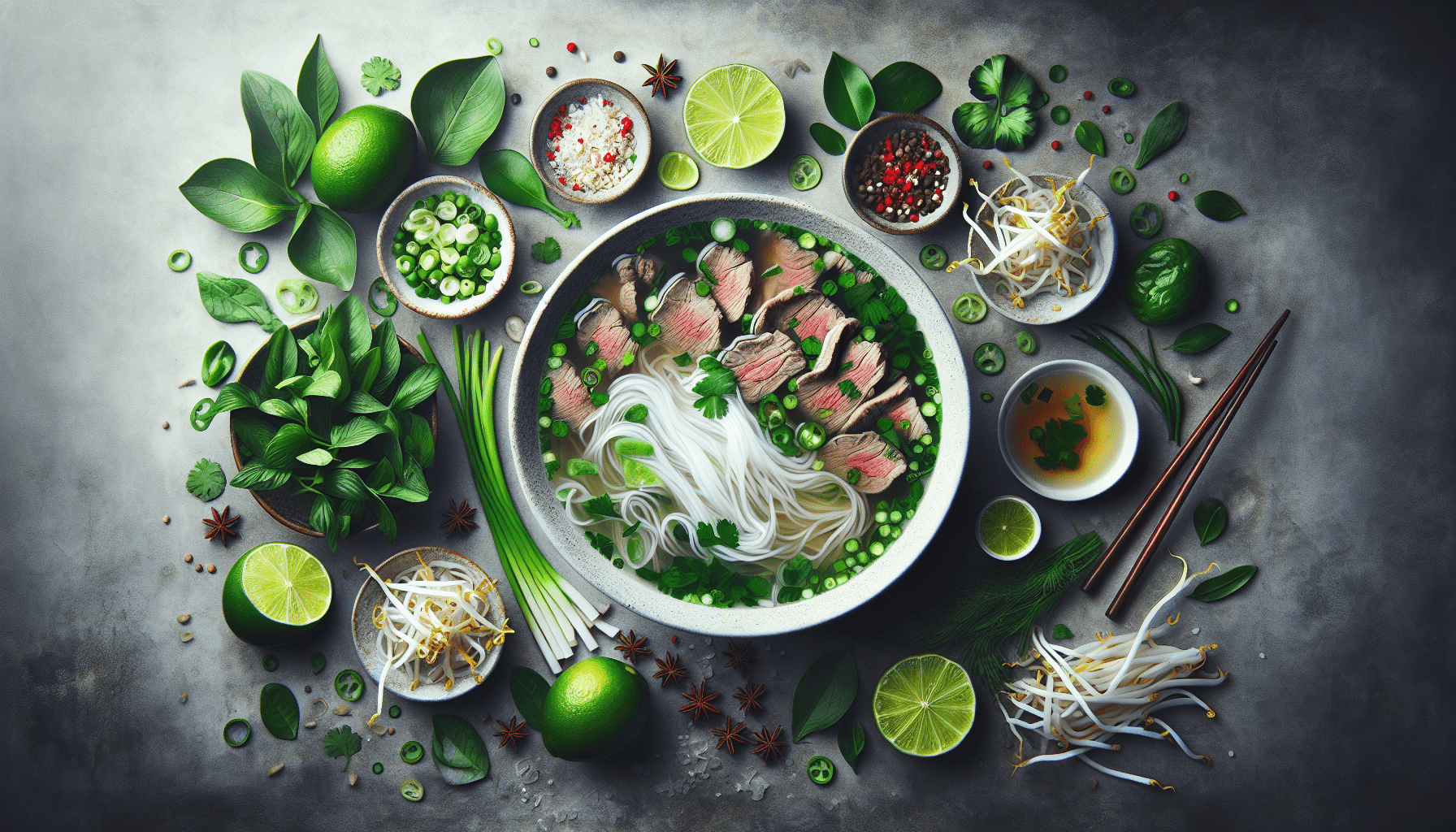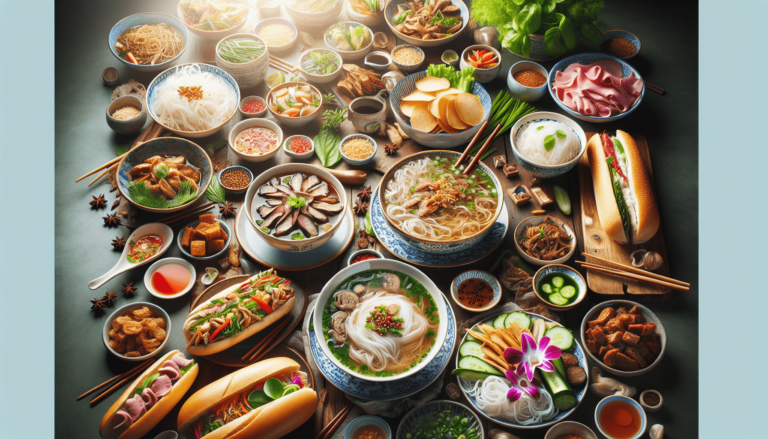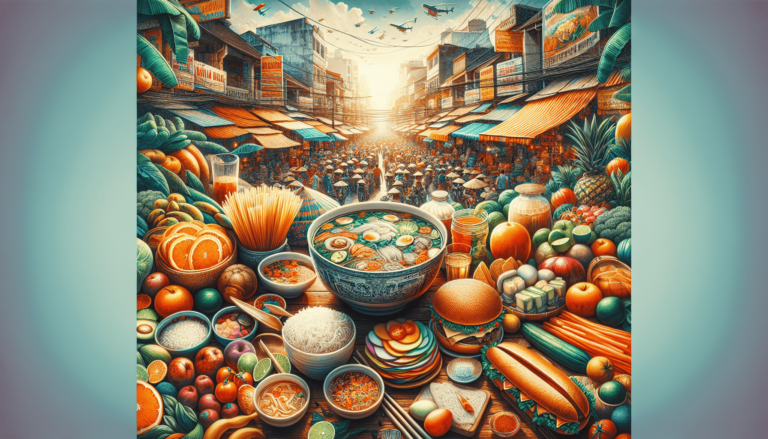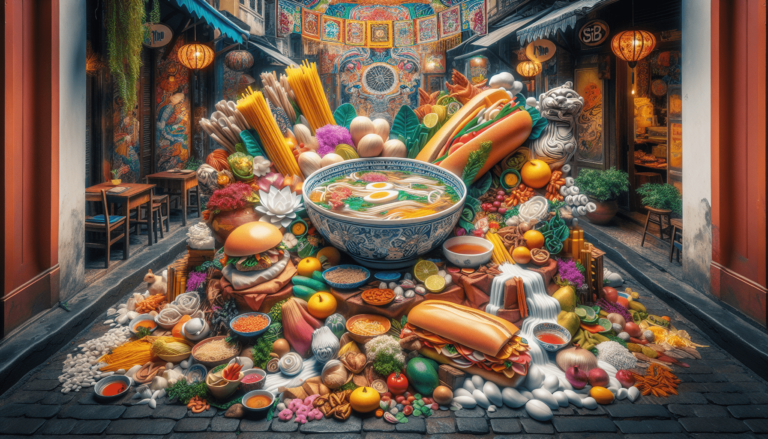If you’re a food lover or an adventurous eater, you’ve probably heard of pho – the beloved Vietnamese dish that tantalizes taste buds with its fragrant broth, tender noodles, and a medley of toppings. But have you ever wondered about plain pho? In this article, we’ll unravel the mystery behind this seemingly simple variation of the iconic dish. From its humble origins to the best places to savor it, get ready to discover what makes plain pho a delightful and satisfying culinary experience. So grab your chopsticks and let’s dig into the fascinating world of plain pho! And if you’re in the Pensacola area, be sure to check out Eurasian Bistro’s diverse locations for an authentic pho experience.

Understanding Plain Pho
What is Pho?
If you haven’t tried it before, you may be wondering – what exactly is pho? Pho is a traditional Vietnamese dish that consists of a flavorful broth, made by simmering beef or chicken bones with various herbs and spices, and served with rice noodles and a selection of garnishes. It is a beloved dish in Vietnamese cuisine and has gained popularity around the world for its unique and delicious flavors.
Origin of Pho
The origins of pho can be traced back to the early 20th century in northern Vietnam. It is believed to have been influenced by both Chinese and French cuisine, resulting in a blend of flavors that is distinctly Vietnamese. Pho was originally a street food, sold by vendors who used carts to serve this nourishing and comforting dish to hungry locals. Over time, it evolved into a staple of Vietnamese cuisine and became a beloved part of the country’s culinary culture.
Components of Plain Pho
Now let’s take a closer look at the components that make up a bowl of plain pho. The main elements are the broth, noodles, and garnishes. The broth, which is the heart and soul of the dish, is made by simmering beef or chicken bones for hours to extract all the rich flavors. It is traditionally flavored with aromatic spices such as star anise, cinnamon, cloves, and coriander seeds. The noodles used in pho are usually flat rice noodles, which have a delicate texture that complements the broth. As for the garnishes, they vary but commonly include bean sprouts, basil, lime, and jalapeños, allowing each person to customize their pho according to their taste preferences.
Significance of Plain Pho in Vietnamese Cuisine
Pho in Vietnam’s Culinary Culture
Pho holds a special place in the culinary culture of Vietnam. It is considered a national dish and is often enjoyed as a hearty breakfast or lunch option. In Vietnam, pho restaurants can be found on nearly every street corner, bustling with locals and tourists alike. It has become deeply ingrained in the Vietnamese way of life, symbolizing warmth, comfort, and togetherness. From vibrant morning markets to family gatherings, pho is a constant presence, bringing people together to savor its delicious flavors and create cherished memories.
Pho as a Staple Vietnamese Dish
Beyond its cultural significance, pho is also a staple in the everyday diet of many Vietnamese people. Its simplicity and nourishing qualities make it a popular choice for meals throughout the day. Whether enjoyed as a quick bowl on the way to work or as a more leisurely dinner with family and friends, pho has become deeply ingrained in the Vietnamese culinary repertoire. It offers a balance of flavors and textures that is both comforting and satisfying, making it an enduring favorite among locals and visitors alike.
Health Benefits of Plain Pho
Nutritional Composition of Pho
Not only is plain pho incredibly delicious, but it also offers several health benefits. The nutritional composition of pho varies depending on the ingredients used, but it generally provides a good balance of macronutrients. The beef or chicken in the broth provides a source of protein, while the rice noodles offer carbohydrates for sustained energy. The broth itself is low in calories and can be a good source of vitamins and minerals, especially when made with a variety of bones and aromatic herbs. The garnishes, such as bean sprouts and herbs, add additional fiber, vitamins, and antioxidants to the dish.
Medical Value of Pho Ingredients
Many of the ingredients used in plain pho also carry potential health benefits. Aromatic herbs like star anise, cinnamon, and coriander seeds are known for their anti-inflammatory and antioxidant properties. These herbs not only add complexity to the flavor profile of pho but may also contribute to reducing the risk of chronic diseases. Additionally, ingredients like ginger and garlic, which are commonly used in pho, are believed to have immune-boosting and antimicrobial properties. Overall, the combination of these ingredients in plain pho makes it not just a delicious meal, but also a nourishing one with potential health benefits.
Culinary Features of Plain Pho
How Plain Pho is Prepared
Preparing a bowl of plain pho is a labor of love, requiring time, patience, and attention to detail. The process usually begins with simmering beef or chicken bones, along with aromatic spices and herbs, for several hours. This slow and gentle simmer allows the flavors to develop and infuse into the broth. Meanwhile, the rice noodles are cooked separately and then combined with the fragrant broth. The garnishes, such as bean sprouts, basil, lime, and jalapeños, are prepared fresh and added to the bowl just before serving. The result is a bowl of plain pho that is rich in flavor, with a delicate balance of aromas and textures.
Distinct Flavors of Plain Pho
What sets plain pho apart from other dishes is its distinct flavors. The complex broth, infused with a medley of spices, creates a fragrant and aromatic base. The combination of star anise, cinnamon, cloves, and coriander seeds lends a warm and slightly sweet note to the broth. When combined with the umami depth of the simmered bones, the result is a flavorful and deeply satisfying broth that forms the backbone of the dish. The rice noodles, with their soft and silky texture, provide a delicate contrast to the rich broth. Lastly, the fresh and crisp garnishes add brightness and a touch of herbaceousness to the overall flavor profile of plain pho.

Pho Variations
Toppings and Customizable Pho
While plain pho is a delicious and satisfying dish on its own, it also offers endless possibilities for customization. Pho restaurants often provide an array of toppings and garnishes, allowing each person to tailor their bowl to their liking. Common toppings include thinly sliced beef or chicken, meatballs, tripe, or tendons. These additional proteins can be added to the bowl before serving, enhancing the flavor and adding more substance to the dish. Some restaurants even offer vegetarian or vegan options, replacing the traditional meat-based broth with a flavorful vegetable broth and adding tofu or plant-based protein alternatives.
Difference Between Plain Pho and Other Pho Variations
While plain pho is the most traditional and well-known variation, there are several other popular pho variations worth exploring. One such variation is pho tai, which features thinly sliced raw beef that cooks in the hot broth when served. Another popular variation is pho ga, which uses chicken instead of beef as the main protein. There is also pho chay, a vegetarian version of pho that typically features tofu or mushrooms as the protein of choice. These variations offer unique flavor profiles while still maintaining the essential elements that make pho so beloved – the fragrant broth, rice noodles, and an assortment of fresh garnishes.
Serving and Eating Plain Pho
How Plain Pho is Served
Plain pho is typically served in a large bowl, accompanied by a plate of garnishes and condiments. Before the pho is brought to the table, the broth is strained to remove any impurities, ensuring a clear and flavorful base. The noodles are placed in the bottom of the bowl, and the hot broth is then poured over them. The garnishes, such as bean sprouts, basil, lime, and jalapeños, are arranged on a separate plate or in small bowls for diners to add according to their preference. Additional condiments like hoisin sauce and sriracha can be added to taste, allowing each person to customize their bowl of plain pho to suit their individual palate.
Traditional way to Eat Pho
When it comes to eating pho, there is a traditional method that many Vietnamese people follow. It involves using a spoon and chopsticks to enjoy the various components of the dish. The chopsticks are used to pick up the noodles, meat, and garnishes, while the spoon is used to sip the broth. Diners often take a mouthful of noodles, meat, and garnishes, and then use the spoon to scoop up some broth to accompany each bite. The combination of textures and flavors in each mouthful creates a delightful and satisfying eating experience. It’s a communal and interactive way of enjoying pho, allowing friends and family to bond over a shared love for this beloved Vietnamese dish.
Plain Pho Outside Vietnam
Adaptation and Fusion
As Vietnamese cuisine has gained global recognition, so too has plain pho. In different parts of the world, pho has been adapted and fused with local ingredients and flavors to create unique interpretations of the dish. From pho with a French twist in Paris to pho with a Mexican influence in California, these adaptations showcase the versatility of this humble dish. While some purists may argue that these variations stray too far from the traditional formula, they also represent the evolution and diversity of pho as it travels and integrates into different culinary landscapes.
Impact of Globalization on Plain Pho’s Popularity
One cannot deny the impact of globalization on the popularity of plain pho. With the advent of travel, migration, and a growing appreciation for diverse cuisines, pho has found its way onto menus around the world. Its comforting flavors and unique combination of ingredients have captured the hearts (and taste buds) of people from all walks of life. Today, it is not uncommon to find pho restaurants in major cities across the globe, catering to both Vietnamese communities and curious food enthusiasts eager to explore the complexities of this iconic dish.
Pho in Pensacola, Florida
Eurasian Bistro Locations in Pensacola
If you find yourself in Pensacola, Florida, and craving a delicious bowl of plain pho, look no further than Eurasian Bistro. With multiple locations conveniently situated in the area, Eurasian Bistro offers a taste of authentic Vietnamese cuisine, including their take on the beloved pho. Whether you’re a long-time pho enthusiast or new to this culinary delight, Eurasian Bistro is a must-visit destination for a satisfying and flavorful dining experience.
Experience of Plain Pho at Eurasian Bistro
When dining at Eurasian Bistro, you can expect a dining experience that is both welcoming and authentic. The plain pho at Eurasian Bistro is prepared with care and attention to detail, ensuring a bowl of pho that is flavorful and satisfying. The fragrant broth, made from simmered bones and aromatic spices, serves as the foundation of this beloved dish. The rice noodles are cooked to perfection, providing a delicate texture that perfectly complements the rich broth. With a selection of fresh garnishes and condiments on the side, you can customize your bowl of plain pho to suit your taste preferences. At Eurasian Bistro, you can savor the flavors of Vietnam in a warm and inviting atmosphere, making for a memorable dining experience.
Home Preparation of Plain Pho
Essential Ingredients for Plain Pho
While enjoying pho at a restaurant is a delightful experience, you can also recreate the flavors of plain pho in the comfort of your own home. To do so, you will need a few essential ingredients. The key components include beef or chicken bones for the broth, aromatic spices like star anise, cinnamon, cloves, and coriander seeds, as well as rice noodles. Additionally, you will want to have garnishes such as bean sprouts, basil, lime, and jalapeños to complete the dish. With these ingredients at hand, you can embark on a culinary adventure and prepare a satisfying bowl of plain pho in your own kitchen.
Step by Step Cooking Process
While preparing plain pho at home may seem intimidating, breaking it down into steps can make the process more manageable. Here’s a step-by-step guide to help you along the way:
-
Begin by selecting high-quality beef or chicken bones. These will form the base of your broth and provide the deep flavors that are characteristic of pho.
-
Clean and blanch the bones to remove any impurities. This can be done by boiling them for a few minutes and then rinsing them under cold water.
-
Place the bones in a large pot and cover them with water. Bring the water to a boil, then reduce the heat to a simmer.
-
Add aromatic spices such as star anise, cinnamon, cloves, and coriander seeds to the pot. These spices will infuse the broth with their warm and fragrant flavors.
-
Allow the broth to simmer for several hours, skimming off any impurities that rise to the surface. This slow and gentle simmer will extract all the flavors from the bones and spices, resulting in a rich and delicious broth.
-
While the broth is simmering, cook the rice noodles according to the package instructions. Rinse them under cold water to prevent sticking, and set them aside.
-
Prepare the garnishes by washing and chopping the bean sprouts, basil, and jalapeños. Slice the lime into wedges for squeezing into the pho.
-
Once the broth is ready, strain it to remove the bones and spices, leaving behind a clear and flavorful liquid.
-
To assemble the pho, place a portion of cooked rice noodles in a bowl. Pour the hot broth over the noodles, covering them completely.
-
Add your desired garnishes to the bowl, customizing the pho to your taste. Feel free to add additional flavors with condiments like hoisin sauce and sriracha.
-
Serve the plain pho hot and enjoy it immediately, savoring the fragrant broth, tender noodles, and fresh garnishes.
Preparing plain pho at home allows you to appreciate the intricacies of this beloved dish, and you can feel a sense of accomplishment as you savor the flavors you have created.
Concluding thoughts on Plain Pho
Misconceptions about Pho
Despite its popularity, there are some misconceptions surrounding pho. One common misconception is that pho is a heavily spiced and spicy dish. While pho does use aromatic spices and is often served with condiments like jalapeños, the spiciness can be adjusted according to personal preference. In its purest form, plain pho is not excessively spicy but offers a harmonious balance of flavors.
Another misconception is that pho is difficult to prepare at home. While it may require some time and attention, making pho from scratch can be a rewarding experience. With the right ingredients and an understanding of the process, you can recreate the flavors of plain pho in your own kitchen.
Influence of Pho on Modern Vietnamese identity
Plain pho, with its rich heritage and cultural significance, plays a role in shaping modern Vietnamese identity. As a dish deeply rooted in tradition, it serves as a symbol of Vietnamese culinary heritage and has become a source of pride for the nation. Pho represents the resilience and adaptability of the Vietnamese people, as well as their ability to create something truly extraordinary out of humble ingredients. From street stalls to high-end restaurants, pho is a reminder of the vibrant and diverse culinary landscape that defines modern Vietnam.
In conclusion, plain pho is much more than just a bowl of soup. It is a culinary masterpiece that embodies the flavors, history, and cultural significance of Vietnam. From its humble origins as a street food to its global popularity today, plain pho continues to captivate the hearts and palates of people around the world. So why not indulge in a bowl of plain pho and experience the magic for yourself? Visit a local Vietnamese restaurant or try your hand at preparing it at home – either way, you’re in for a delicious and satisfying journey into the world of pho.







